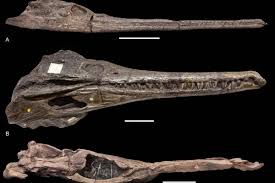Ancient Crocodile Relatives' Sinuses Hindered Deep Diving Evolution

A groundbreaking study published on October 30 in *Royal Society Open Science* reveals that the sinuses of thalattosuchians, ocean-dwelling relatives of modern crocodiles, inhibited their ability to evolve into deep divers akin to whales and dolphins. Conducted by an international team of paleobiologists, the research indicates that the large snout sinuses of these prehistoric reptiles prevented them from exploring deeper waters, a significant constraint not faced by cetaceans, which evolved from land mammals into fully aquatic creatures over a span of approximately 10 million years.
During their evolutionary transition, cetaceans experienced a reduction in bone-enclosed sinuses and developed air sacs outside of their skulls. This adaptation allowed them to withstand the pressure increases associated with deep diving, enabling them to reach extraordinary depths—hundreds of meters for dolphins and thousands for whales. Thalattosuchians lived during the Jurassic and Cretaceous periods and are classified into two primary groups: Teleosauridae, which were similar to modern gharial crocodiles and likely inhabited coastal waters and estuaries, and Metriorhynchidae, which were fully adapted to marine life, exhibiting streamlined bodies and flipper-like limbs.
Researchers from the University of Southampton, University of Edinburgh, and other institutions aimed to determine whether thalattosuchians had developed sinus adaptations comparable to those of cetaceans. They employed computed tomography to analyze the sinuses of 11 thalattosuchian skulls alongside those of 14 modern crocodile species and six other fossil species.
The findings revealed a reduction in braincase sinuses as thalattosuchians evolved towards a more aquatic lifestyle, mirroring the evolutionary trajectory of cetaceans. Dr. Mark Young, the lead author from the University of Southampton, explained, "The regression of braincase sinuses in thalattosuchians reflects the changes seen in cetaceans, diminishing during their semi-aquatic phases and further as they became fully aquatic. Both groups developed extracranial sinuses; however, the expansive snout sinus systems in metriorhynchids restricted their ability to dive deeply."
At greater depths, the air within the sinuses would compress, leading to discomfort and potential damage due to the inability to equalize pressure. Unlike cetaceans, which have evolved highly efficient kidneys to filter salt from seawater, thalattosuchians likely relied on salt glands for excretion. The researchers propose that the complex snout sinuses in metriorhynchids may have played a role in draining their salt glands, similar to the behavior observed in modern marine iguanas. Dr. Young elaborated, "When metriorhynchids' sinuses experienced a contraction effect similar to a sneeze, it could have expelled excess salt, mitigating the issue of 'encrustation' that affects animals with salt glands."
This study sheds light on the major evolutionary transitions influenced by species' anatomy and biology. Dr. Julia Schwab, a coauthor from the University of Manchester, remarked on the fascinating adaptations of thalattosuchians to ocean life, highlighting both their similarities and differences from modern cetaceans. Although thalattosuchians became extinct during the Early Cretaceous period, Dr. Young concluded, "We can only speculate whether, given more evolutionary time, they might have further converged with modern cetaceans or if their need to drain salt glands presented an insurmountable barrier to further aquatic specialization." The research was funded by the Leverhulme Trust.
Story Source:
Materials provided by University of Southampton. The original text of this story is licensed under a Creative Commons License. Note: Content may be edited for style and length.
Journal Reference:
- Mark T. Young, Julia A. Schwab, David Dufeau, Rachel A. Racicot, Thomas Cowgill, Charlotte I. W. Bowman, Lawrence M. Witmer, Yanina Herrera, Robert Higgins, Lindsay Zanno, Xu Xing, James Clark, Stephen L. Brusatte. Skull sinuses precluded extinct crocodile relatives from cetacean-style deep diving as they transitioned from land to sea. Royal Society Open Science, 2024; 11 (10) DOI: 10.1098/rsos.241272

0 Comments